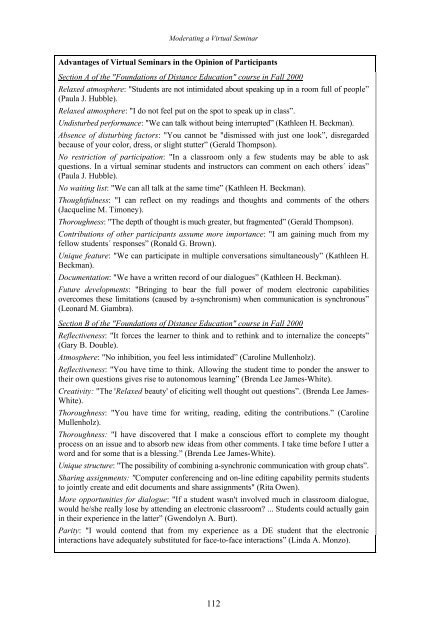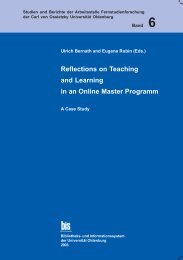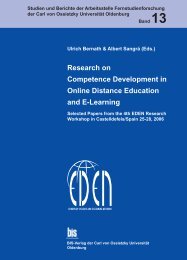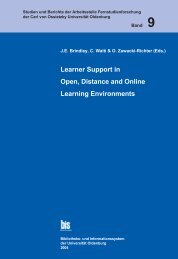Distance Education in Transition - Master of Distance Education ...
Distance Education in Transition - Master of Distance Education ...
Distance Education in Transition - Master of Distance Education ...
Create successful ePaper yourself
Turn your PDF publications into a flip-book with our unique Google optimized e-Paper software.
Moderat<strong>in</strong>g a Virtual Sem<strong>in</strong>ar<br />
Advantages <strong>of</strong> Virtual Sem<strong>in</strong>ars <strong>in</strong> the Op<strong>in</strong>ion <strong>of</strong> Participants<br />
Section A <strong>of</strong> the "Foundations <strong>of</strong> <strong>Distance</strong> <strong>Education</strong>" course <strong>in</strong> Fall 2000<br />
Relaxed atmosphere: "Students are not <strong>in</strong>timidated about speak<strong>in</strong>g up <strong>in</strong> a room full <strong>of</strong> people”<br />
(Paula J. Hubble).<br />
Relaxed atmosphere: "I do not feel put on the spot to speak up <strong>in</strong> class”.<br />
Undisturbed performance: "We can talk without be<strong>in</strong>g <strong>in</strong>terrupted” (Kathleen H. Beckman).<br />
Absence <strong>of</strong> disturb<strong>in</strong>g factors: "You cannot be "dismissed with just one look”, disregarded<br />
because <strong>of</strong> your color, dress, or slight stutter” (Gerald Thompson).<br />
No restriction <strong>of</strong> participation: "In a classroom only a few students may be able to ask<br />
questions. In a virtual sem<strong>in</strong>ar students and <strong>in</strong>structors can comment on each others´ ideas”<br />
(Paula J. Hubble).<br />
No wait<strong>in</strong>g list: "We can all talk at the same time” (Kathleen H. Beckman).<br />
Thoughtfulness: "I can reflect on my read<strong>in</strong>gs and thoughts and comments <strong>of</strong> the others<br />
(Jacquel<strong>in</strong>e M. Timoney).<br />
Thoroughness: "The depth <strong>of</strong> thought is much greater, but fragmented” (Gerald Thompson).<br />
Contributions <strong>of</strong> other participants assume more importance: "I am ga<strong>in</strong><strong>in</strong>g much from my<br />
fellow students´ responses” (Ronald G. Brown).<br />
Unique feature: "We can participate <strong>in</strong> multiple conversations simultaneously” (Kathleen H.<br />
Beckman).<br />
Documentation: "We have a written record <strong>of</strong> our dialogues” (Kathleen H. Beckman).<br />
Future developments: "Br<strong>in</strong>g<strong>in</strong>g to bear the full power <strong>of</strong> modern electronic capabilities<br />
overcomes these limitations (caused by a-synchronism) when communication is synchronous”<br />
(Leonard M. Giambra).<br />
Section B <strong>of</strong> the "Foundations <strong>of</strong> <strong>Distance</strong> <strong>Education</strong>" course <strong>in</strong> Fall 2000<br />
Reflectiveness: "It forces the learner to th<strong>in</strong>k and to reth<strong>in</strong>k and to <strong>in</strong>ternalize the concepts”<br />
(Gary B. Double).<br />
Atmosphere: "No <strong>in</strong>hibition, you feel less <strong>in</strong>timidated” (Carol<strong>in</strong>e Mullenholz).<br />
Reflectiveness: "You have time to th<strong>in</strong>k. Allow<strong>in</strong>g the student time to ponder the answer to<br />
their own questions gives rise to autonomous learn<strong>in</strong>g” (Brenda Lee James-White).<br />
Creativity: "The 'Relaxed beauty' <strong>of</strong> elicit<strong>in</strong>g well thought out questions”. (Brenda Lee James-<br />
White).<br />
Thoroughness: "You have time for writ<strong>in</strong>g, read<strong>in</strong>g, edit<strong>in</strong>g the contributions.” (Carol<strong>in</strong>e<br />
Mullenholz).<br />
Thoroughness: "I have discovered that I make a conscious effort to complete my thought<br />
process on an issue and to absorb new ideas from other comments. I take time before I utter a<br />
word and for some that is a bless<strong>in</strong>g.” (Brenda Lee James-White).<br />
Unique structure: "The possibility <strong>of</strong> comb<strong>in</strong><strong>in</strong>g a-synchronic communication with group chats”.<br />
Shar<strong>in</strong>g assignments: "Computer conferenc<strong>in</strong>g and on-l<strong>in</strong>e edit<strong>in</strong>g capability permits students<br />
to jo<strong>in</strong>tly create and edit documents and share assignments" (Rita Owen).<br />
More opportunities for dialogue: "If a student wasn't <strong>in</strong>volved much <strong>in</strong> classroom dialogue,<br />
would he/she really lose by attend<strong>in</strong>g an electronic classroom? ... Students could actually ga<strong>in</strong><br />
<strong>in</strong> their experience <strong>in</strong> the latter” (Gwendolyn A. Burt).<br />
Parity: "I would contend that from my experience as a DE student that the electronic<br />
<strong>in</strong>teractions have adequately substituted for face-to-face <strong>in</strong>teractions” (L<strong>in</strong>da A. Monzo).<br />
112





